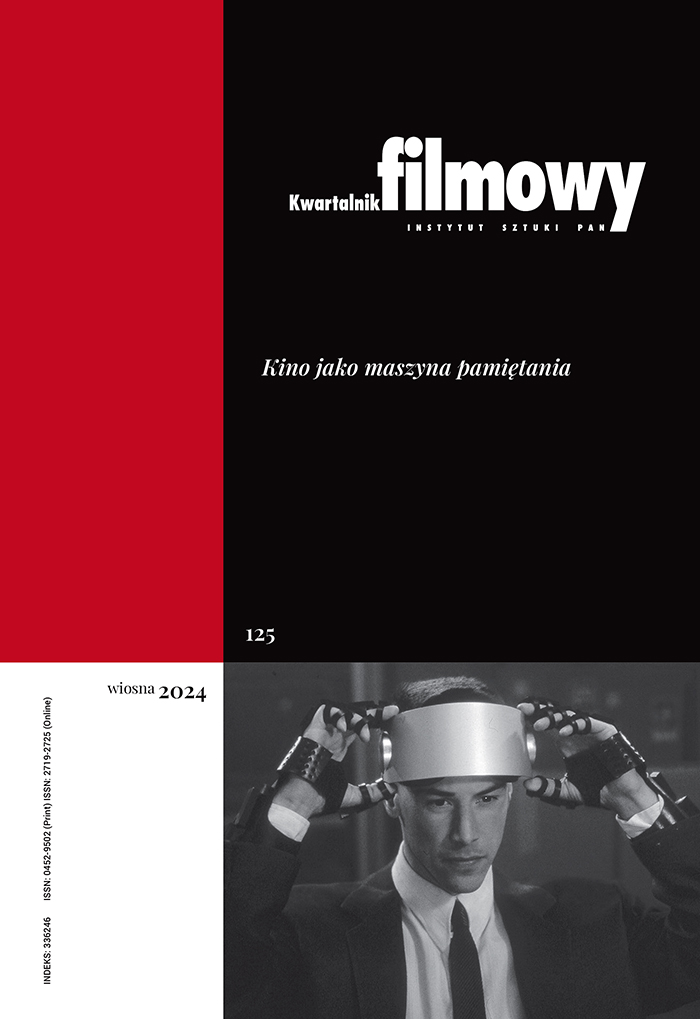“Let’s Make a Meta-Movie”: Metalepsis and Other Narrative Games in the Films by Spike Jonze and Charlie Kaufman
Abstract
The author analyses the intriguing and carefully constructed film diptych from the director Spike Jonze and the scriptwriter Charlie Kaufman, consisting of two films: Being John Malkovich (1999) and Adaptation (2002). In their diptych Jonze and Kaufman cleverly use the habit of viewers to separate extra- and intra textual spheres within the narrative. They engage the viewers into a game based on the apparent mixing of reality with fiction on several levels at once. Being John Malkovich and Adaptation create a complicated construction that provokes and deceives the viewer by using and mixing multiple levels of fiction and apparent reality. In order to disturb the hierarchical dependency between reality and fiction, Jonze and Kaufman applied metaleptic solutions in both films. And so a complicated, pan-fictional narrative structure, with elements of auto reference was created.
Keywords:
Spike Jonze, Charlie Kaufman, narrativeReferences
Bal Mieke, Notes on Narrative Embedding, „Poetics Today” 1981, nr 2, 2, , s. 41-59.
DOI: https://doi.org/10.2307/1772189
Google Scholar
Borges Jorge L., Częściowe magie Don Kichota, w: Jorge L. Borges, Dalsze dociekania, tłum. A. Sobol-Jurczykowski, Prószyński i S-ka, Warszawa 1999, s. 75.
Google Scholar
Culler Jonathan, Dekonstrukcja i jej konsekwencje dla badań naukowych, tłum. M. B. Fedewicz, w: Dekonstrukcja w badaniach literackich, red. R. Nycz, seria: Tematy teoretycznolite rackie Archiwum przekładów „Pamiętnika Literackiego”, red. M. Głowiński, słowo/obraz terytoria, Gdańsk 2000, s. 86, 322-325, 329.
Google Scholar
Derrida Jacques, List do jednego z japońskich przyjaciół, tłum. J. M. Godzimirski, „Polska Sztuka Ludowa. Konteksty”, 1994, nr 1-2, s. 43-44.
Google Scholar
Derrida Jacques, Pozycje. Rozmowy z Henri Ronsem, Julią Kristevą, Jeanem-Louis Houdebinem i Guy Scarpettą, tłum. A. Dziadek, Kwartalnik Literacki „FA-art”, Bytom 1997, s. 41.
Google Scholar
Dragunoiu Dana, Psychoanalysis, film theory, and the case of Being John Malkovich, „Film Criticism” 2001, nr 26:2.
Google Scholar
French Philip, The Towering Twins, „The Observer” 2003, March 2.
Google Scholar
Genette Gérard, Narrative Discourse: An Essay in Method, tłum. J. E. Lewin, Cornell University Press, Ithaca 1980.
Google Scholar
Genette Gérard, Paratexts: Thresholds of interpretation, tłum. J. E. Lewin, Cambridge University Press, Cambridge 1997.
Google Scholar
Hilderbrand Lucas, niezatytułowany wywiad, „Film Quarterly” 2004, 58, 1, s. 41.
DOI: https://doi.org/10.1525/fq.2004.58.1.36
Google Scholar
Jahn Manfred, Narratology: A Guide to the Theory of Narrative, English Department, University of Cologne 2005, s. 4, 40.
Google Scholar
Kobel Peter, The Fun and Games of living virtual life, „The New York Times” 1999, October 24.
Google Scholar
Łebkowska Anna, Między teoriami a fikcją literacką, Universitas, Kraków 2001.
Google Scholar
Leigh Danny, Let’s Make a Meta-movie, „The Guardian” 2003, Feburary 14.
Google Scholar
Man Paul de, Alegorie czytania. Język figuralny u Rousseau, Nietzschego i Prousta, tłum. A. Przybysławski, Kraków 2004, s. 156.
Google Scholar
Mitchell W. J. T., Picture Theory, The University of Chicago Press, Chicago 1994.
Google Scholar
Nietzsche Friedrich, Wola mocy. Próba przemiany wszystkich wartości, tłum. S. Frycz, K. Drzewiecki, Wydawnictwo Zielona Sowa, Kraków 2003, s. 183.
Google Scholar
Nycz Ryszard, Słowo wstępne, w: Dekonstrukcja w badaniach literackich, red. R. Nycz, seria: Tematy teoretycznolite rackie Archiwum przekładów „Pamiętnika Literackiego”, red. M. Głowińskie, słowo/obraz terytoria, Gdańsk 2000, s. 11.
Google Scholar
O’Hagan Sean, Who’s the proper Charlie?, „The Observer” 2003, February 9.
Google Scholar
Orlean Susan, The Orchid Thief, Balentine Books, New York 2002.
Google Scholar
Peranson Mark, Brief Interviews with Devious Men, „The Village Voice” 2002, December 3.
Google Scholar
Repass Scott, nietytułowany wywiad, „Film Quarterly”, 2002, t. 56, nr 1, s. 29-30.
DOI: https://doi.org/10.1525/fq.2002.56.1.29
Google Scholar
Rozmowa Dereka Attrige’a z Jacques’em Derridą, Ta dziwna instytucja zwana literaturą, tłum. M. P. Markowski, w: Dekonstrukcja w badaniach literackich, red. R. Nycz, seria: Tematy teoretycznolite rackie Archiwum przekładów „Pamiętnika Literackiego”, red. M. Głowińskie, słowo/obraz terytoria, Gdańsk 2000, s. 69-70.
Google Scholar
Słownik terminów literackich, red. J. Sławiński, Ossolineum, Warszawa 1998, s. 302, 308.
Google Scholar
Stam Robert, R. Burgonye, S. Flitterman-Lewis, Cine-semiology, w: New Vocabulaires in Film Semiotics, Routledge, London – New York 1992, s. 17, 38, 200.
Google Scholar
Swoboda Tomasz, Zakrzywienie przestrzeni reprezentacji. Parę słów o metalepsie, „Teksty drugie”, 2005, nr 5 (59), s. 183-185.
Google Scholar
Todorov Tzvetan, Poetyka, tłum. S. Cichowicz, Wiedza Powszechna, Warszawa 1984, s. 29-31, 60-61.
Google Scholar
Uspienski Boris, Ramy dzieła sztuki, w: Uspienski Boris, Poetyka kompozycji, struktura tekstu artystycznego i typologia form kompozycji, tłum. P. Fast, Wydawnictwo Śląsk, Katowice 1997, s. 201, 207.
Google Scholar
Authors
Katarzyna Statkiewicz-Zawadzkakwartalnik.filmowy@ispan.pl
independent researcher Poland
Absolwentka Instytutu Kultury Polskiej UW. Po ukończeniu Uniwersyteckiego Kolegium Kształcenia Nauczycieli Języka Angielskiego w Warszawie pracuje z dziećmi i młodzieżą.
Statistics
Abstract views: 187PDF downloads: 176
License
Copyright (c) 2010 Katarzyna Statkiewicz-Zawadzka

This work is licensed under a Creative Commons Attribution 4.0 International License.
The author grants the publisher a royalty-free non-exclusive licence (CC BY 4.0) to use the article in Kwartalnik Filmowy, retains full copyright, and agrees to identify the work as first having been published in Kwartalnik Filmowy should it be published or used again (download licence agreement). The journal is published under the CC BY 4.0 licence. By submitting an article, the author agrees to make it available under this licence.
In issues from 105-106 (2019) to 119 (2022) all articles were published under the CC BY-NC-ND 4.0 licence. During this period the authors granted a royalty-free non-exclusive licence (CC BY-ND 4.0) to use their article in „Kwartalnik Filmowy”, retained full copyright, and agreed to identify the work as first having been published in our journal should it be published or used again.











